Plants that can grow in water offer a unique and low-maintenance option for indoor gardening enthusiasts. These hydroponic wonders include a diverse range of species, from traditional houseplants like pothos and spider plants to culinary herbs like basil and mint.
With proper care and maintenance, these plants that can grow in water thrive in water alone, eliminating the need for soil. Not only do they add greenery and vitality to indoor spaces, but they also provide an opportunity for creativity in arranging and displaying them in various containers and settings.
Different Types of Plants That Can Grow in Water
Snake Plant
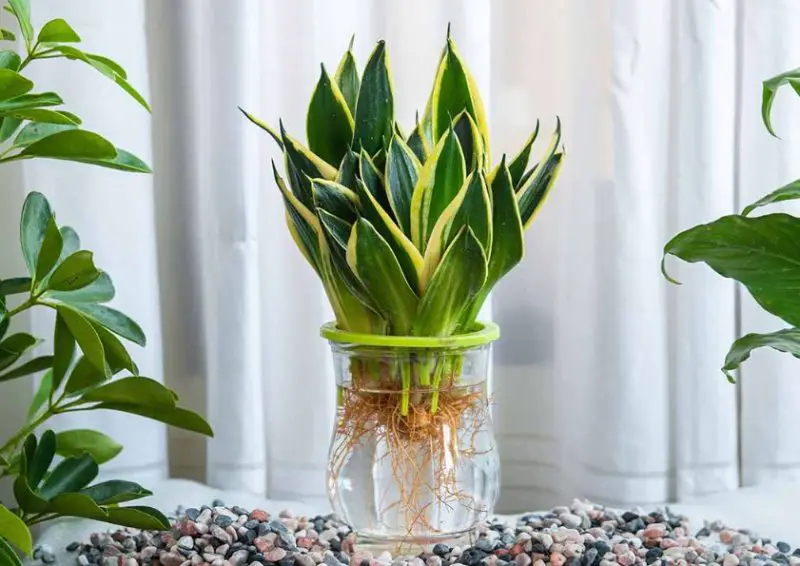
The Snake Plant, also known as Sansevieria or Mother-in-Law’s Tongue, features long, dark green leaves with yellow margins, growing in a striking, architectural manner. Placed in a vase of water on a white table, it thrives in various light conditions, making it ideal for beginners. This resilient plant requires minimal watering and can withstand neglect.
Individual leaves can be rooted in water for long-term growth, with cut sections often used for propagation. To keep tall displays upright, add a layer of pebbles to the vase.
Spider Plant
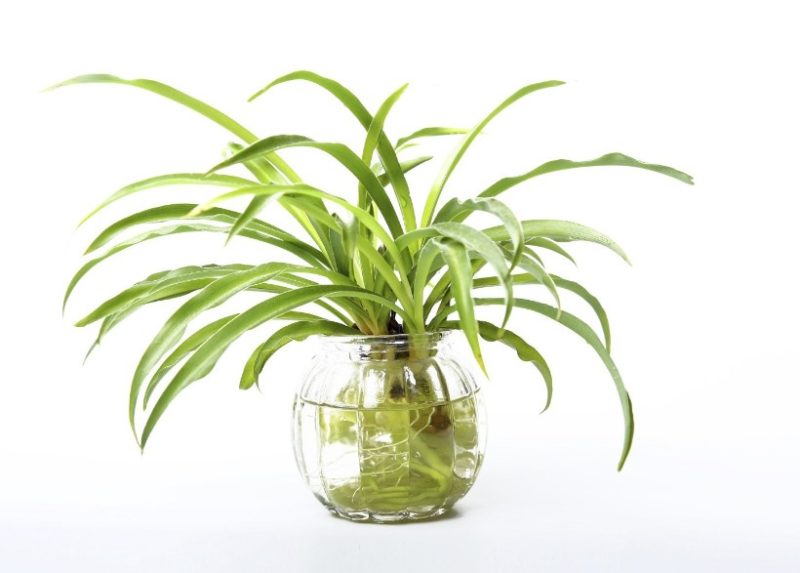
The Spider Plant (Chlorophytum comosum) showcases arching, narrow leaves with green and white stripes, growing in a graceful rosette fashion. Placed in a round vase of water on a wooden table against a soft purple wall, it adds a touch of elegance to any space.
This beginner-friendly plant is safe for pets and produces small plantlets on arching stems that can be easily rooted in water. Careful vase selection is crucial to support the growing foliage and ensure successful propagation.
Satin Pothos
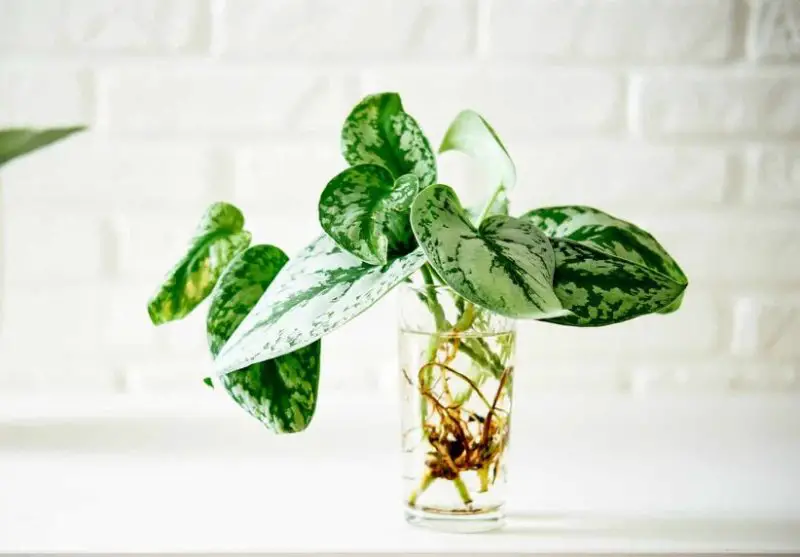
The Satin Pothos (Scindapsus pictus) stands out with its heart-shaped leaves featuring deep green color and silver or silvery-gray variegation. With a soft texture and subtle sheen, it adds a touch of luxury to any indoor space.
Perfect for water growing, this plant offers unique color and texture for indoor settings. To keep its vines upright in shorter vases, you can use clear tape to create a lattice on the vase opening, providing support for the trailing vines.
Anthurium

Anthuriums, commonly known as Flamingo Flowers or Laceleaf, boast glossy, heart-shaped leaves and striking deep red spathes surrounding slender finger-like structures called spadix. Illuminated by the sun on a windowsill, they add a vibrant touch to any space.
Anthuriums come in various colors, with the traditional red being a standout. To enjoy their foliage and flowers long-term, cut part of the stem for display in a vase, adding fertilizer to the water regularly to encourage flowering.
Pink Princess Philodendron
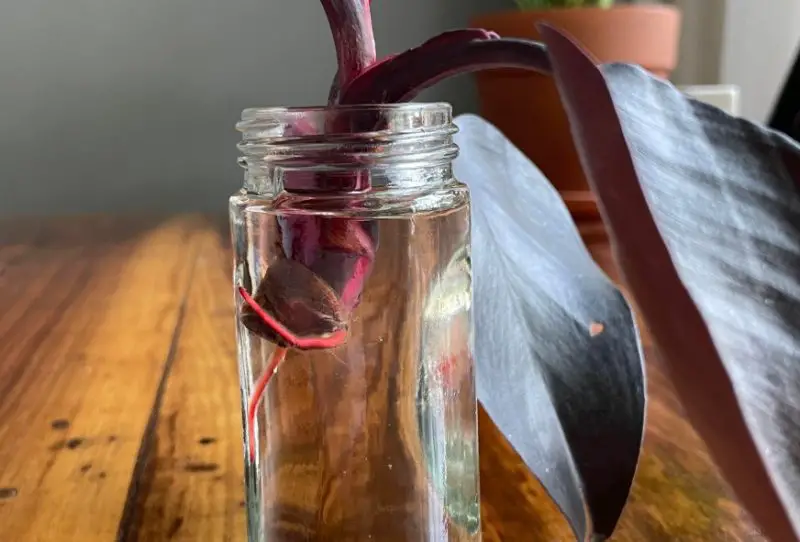
The Pink Princess Philodendron, with its heart-shaped dark green leaves adorned with vibrant pink variegation, stands out with its striking appearance. While it may not be as rare as it once was due to its online popularity, it remains a coveted houseplant.
Like other philodendrons, the Pink Princess can thrive in water with occasional feeding. Providing ample bright indirect light will enhance its vibrant pink variegation, making it a stunning addition to any indoor space.
Split Leaf Philodendron
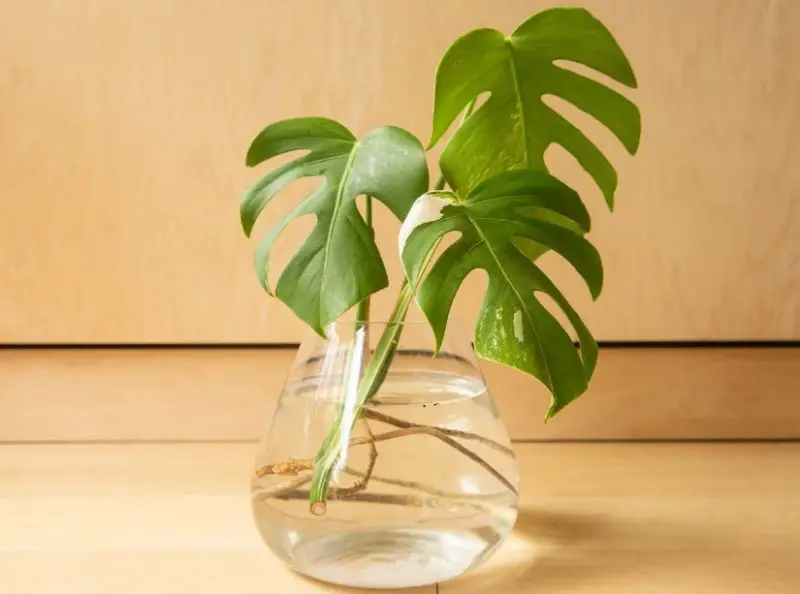
Thaumatophyllum bipinnatifidum, commonly known as the Split-Leaf Philodendron, showcases large, deeply lobed leaves with unique split patterns resembling those of the monstera. While it’s not a true philodendron, it shares similar characteristics.
Displaying its leaves in a vase is a great way to showcase their beauty, especially the larger ones. When propagating in water, ensure to include a node along with the stem cuttings for root development. Cut just below a node using sharp shears for successful root growth.
Peperomia

Peperomia Caperata, known as the “Ripple Peperomia,” features charming, wavy leaves with a deeply textured, crinkled appearance. Celebrated for its rich green hues, this plant adds a touch of elegance to any space. Peperomias offer a wide range of species to enjoy, making them favorites among plant collectors.
Larger species like Watermelon Peperomia are ideal for rooting in vases, while smaller species like Ripple Peperomia can be grown as long as the vase prevents individual leaves from submerging below the water line.
Begonia
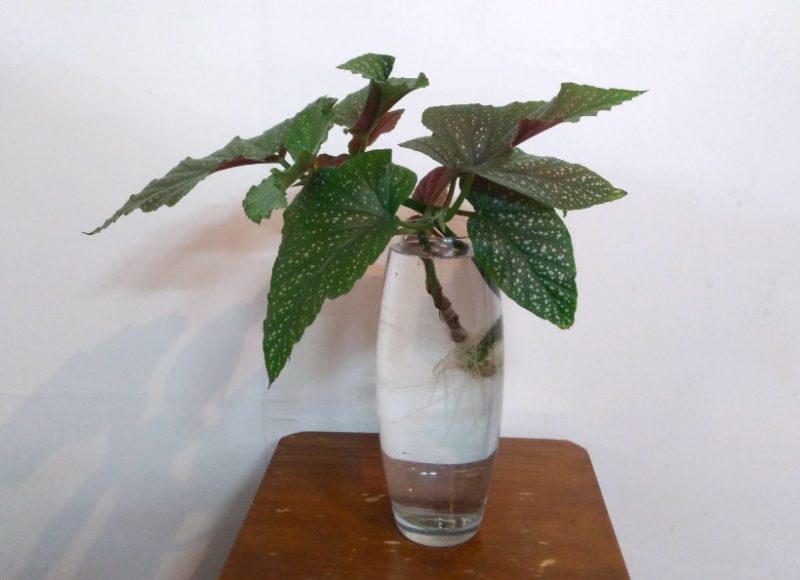
The Polka Dot Begonia, also known as Begonia maculata, stands out with its eye-catching olive green leaves adorned with contrasting silvery-white polka dot patterns. With asymmetrical shapes and burgundy undersides, these leaves are captivating additions to any collection. Begonias bloom reliably indoors, showcasing adorable flowers even when grown in water.
To ensure successful flowering, provide bright indirect light and regular feeding. Place your vase in a well-lit area, and your Begonia will thrive, adding beauty to your space.
African Violet

African Violets, or Saintpaulia, are renowned for their delicate, fuzzy, heart-shaped leaves and charming soft purple flowers. Despite their perceived difficulty, African Violets are versatile and can even be grown in water alone.
Propagating them with individual leaves is simple: trim and root a single leaf to produce a small pup, which can thrive in water for a period of time. To prevent rot, ensure the leaves are kept out of the water during propagation.
Prayer Plant
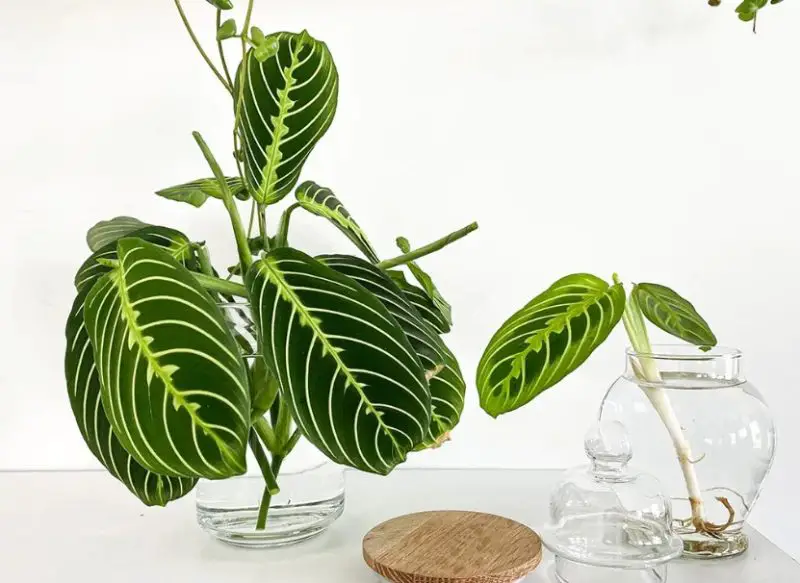
The Prayer Plant, or Maranta leuconeura, boasts broad, oval leaves adorned with intricate patterns and striking red veins. Their stunning, glossy texture and symmetrical patterns make them resemble unreal foliage. Whether in a pot or grown in water, Prayer Plants steal the show with their eye-catching leaves.
Indoors, provide enough light to maintain their vibrant color and upright growth habits, enhancing their beauty and making them a captivating addition to any space.
Polka Dot Plant
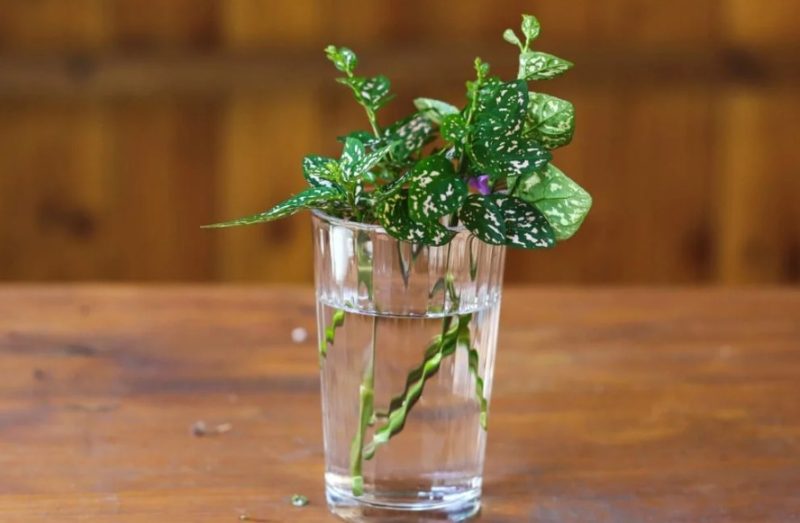
Polka Dot Plants are known for their colorful, spotty leaves and thrive in high humidity. With their vibrant hues, especially shades of pink, they add a pop of color to any space. These plants have relatively thin leaves that can wilt quickly, particularly in low humidity conditions.
Growing them in water can help alleviate this concern, as it ensures consistent moisture levels. When rooting Polka Dot Plant cuttings in water, trim long stems and remove any leaves below the water line to prevent rot.
Swiss Cheese Plant
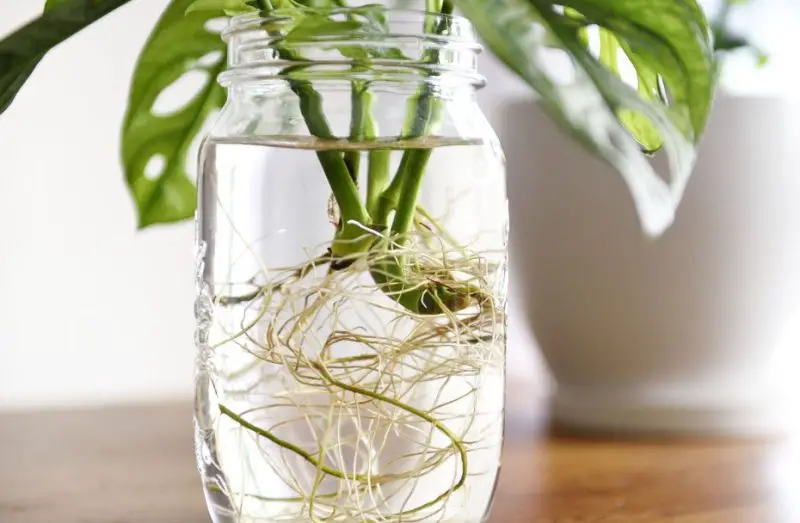
Monstera deliciosa, often called the Swiss Cheese Plant, makes an elegant houseplant with its large, glossy, heart-shaped leaves featuring distinctive perforations. Placed in a clear plastic vase on a white table, the plant thrives in sunlight streaming through a window. Ideal for water growth, Monstera deliciosa is not only visually striking but also easy to care for.
Regular cuttings from larger plants can be kept in vases, where they flourish with minimal maintenance. Remember to trim the roots periodically, as they grow quickly in suitable conditions, ensuring your collection of hydroponic monsteras stays vibrant and healthy.
Swiss Cheese Vine
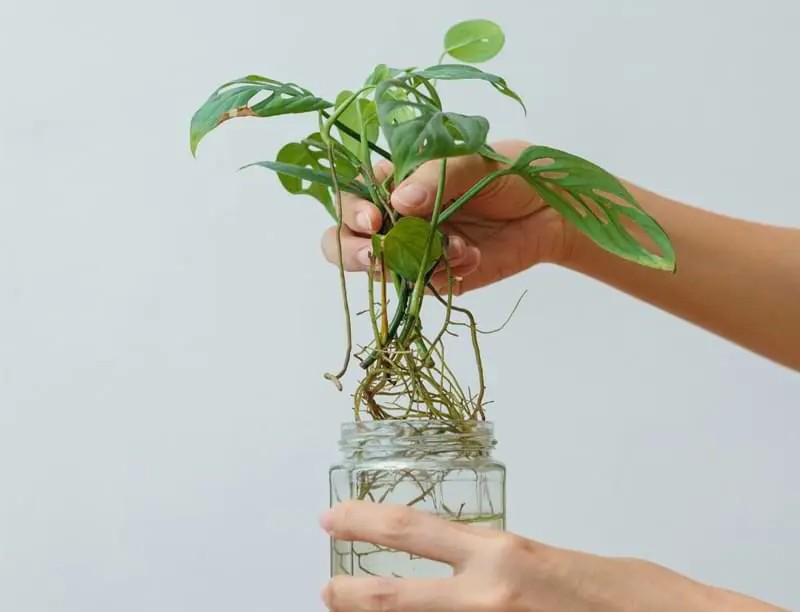
Monstera adansonii, known as the Swiss Cheese Vine, is perfect for water growth with its small, dark green, heart-shaped leaves featuring unique holes. Displayed in a vase on a white background, its trailing vines create an attractive cascading effect. Unlike the larger Monstera deliciosa, these vines gracefully spill over the container’s edge.
Regular trimming allows the plant to fit any vase, and ample indirect light ensures new leaves develop the characteristic fenestrations. This makes Monstera adansonii a delightful and adaptable addition to any collection.
Heartleaf Philodendron
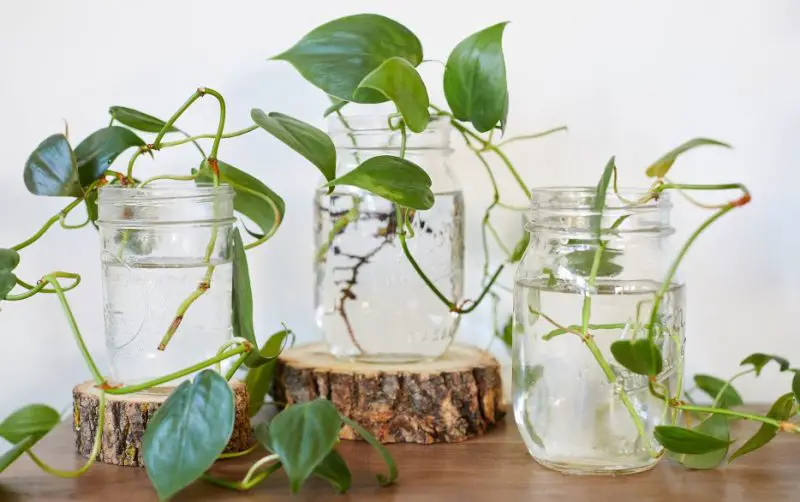
The Heartleaf Philodendron (Philodendron hederaceum) is a popular beginner houseplant with deep green, glossy, heart-shaped leaves that dangle gracefully from trailing vines. Placed in a vase of water on a black, round, wooden table, it thrives with minimal care.
To ensure the leaves remain glossy, add a dash of fertilizer and keep the vase clean. Take cuttings from an established plant using sharp shears, cutting just below a node for optimal rooting and long-term growth.
Philodendron micans
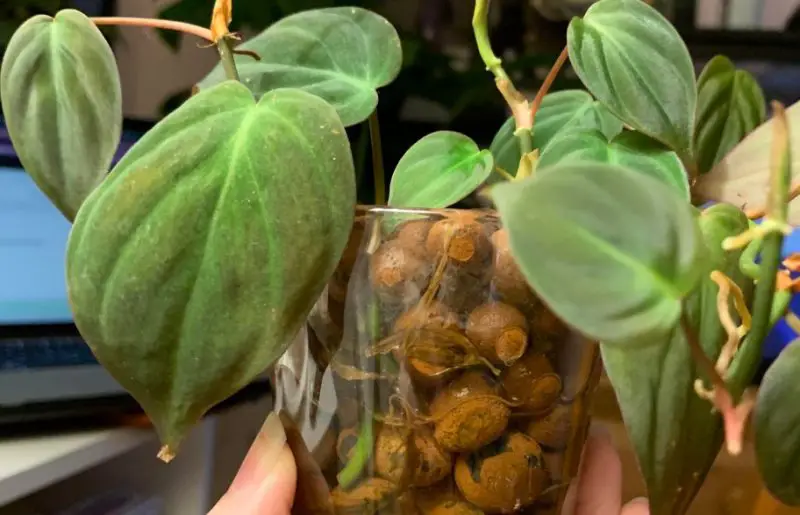
Philodendron micans, displayed in a vase of water against a green background, is renowned for its velvety, deep green, heart-shaped leaves with a rich bronzy undertone. This species, with its luxurious, shimmering foliage, is highly sought after for its unique burgundy and green leaves.
Similar to the heartleaf philodendron, it has become one of the most popular philodendrons. For propagation, cut the vine below a node and place it in a vase. Use a narrow-neck vase to support the thinner stems and ensure successful rooting.
ZZ Plant
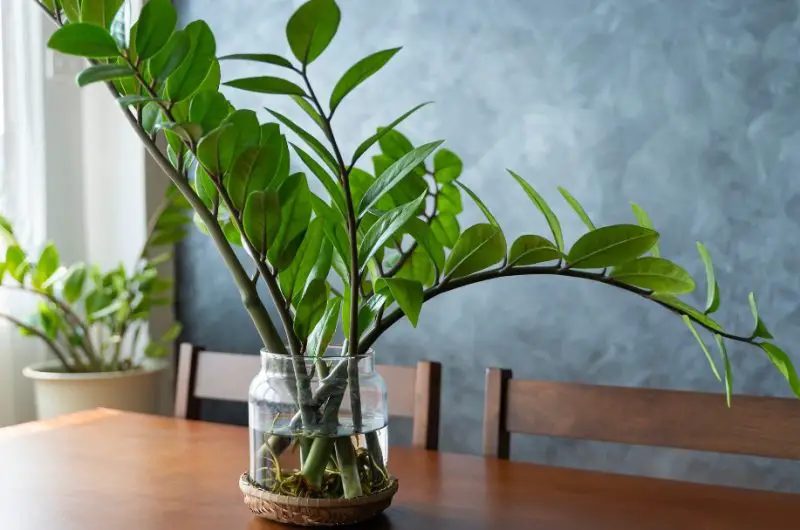
The ZZ Plant, with its glossy, dark green leaves, adds a touch of elegance to any space. While typically not recommended for long-term water growth due to their rhizomatous nature, some ZZ plant cuttings have thrived in vases for months.
Although these plants prefer propagation by division, rooting in water can be attempted with success. Despite the process taking several months and the risk of rot, it’s worth trying for enthusiasts who adore the unique charm of ZZ Plants.
Pothos

Pothos, with its glossy, variegated heart-shaped leaves in shades of green, yellow, or white, thrives in a vase of water indoors and outdoors. These lush leaves grow along long, trailing vines, creating a vibrant display. Numerous captivating pothos varieties exist, and mixing cuttings from different species can create a unique centerpiece.
By combining a few cuttings in the same vase, you can create a striking “Franken-pothos” with intertwined roots, making for an impressive and eye-catching addition to any plant collection.
Fiddle Leaf Fig
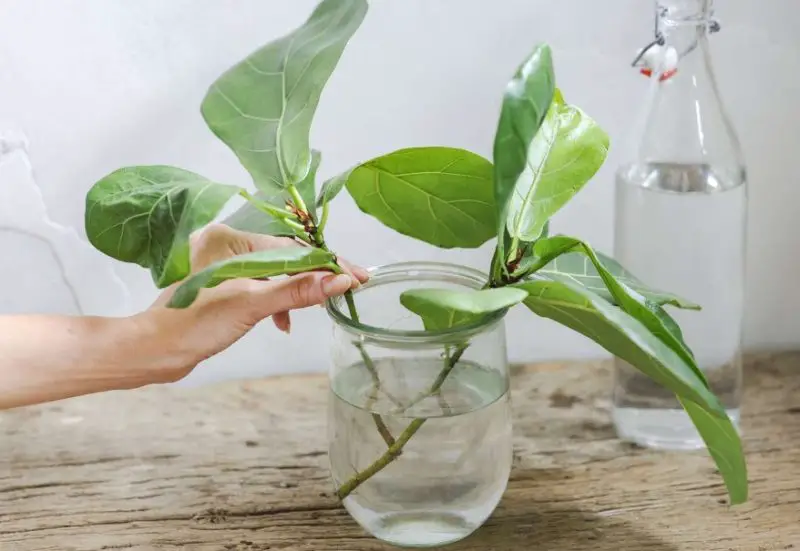
The Fiddle Leaf Fig (Ficus lyrata) is known for its large, leathery, fiddle-shaped leaves, which are deep green, glossy, and prominently veined. Displayed in a vase of water against a white brick wall, these leaves thrive in the right conditions, maintaining their lush, tropical appearance.
Though a single leaf won’t propagate a new plant, it can produce long roots and remain vibrant for long-term display, making it a striking addition to any indoor setting.
Hoya carnosa
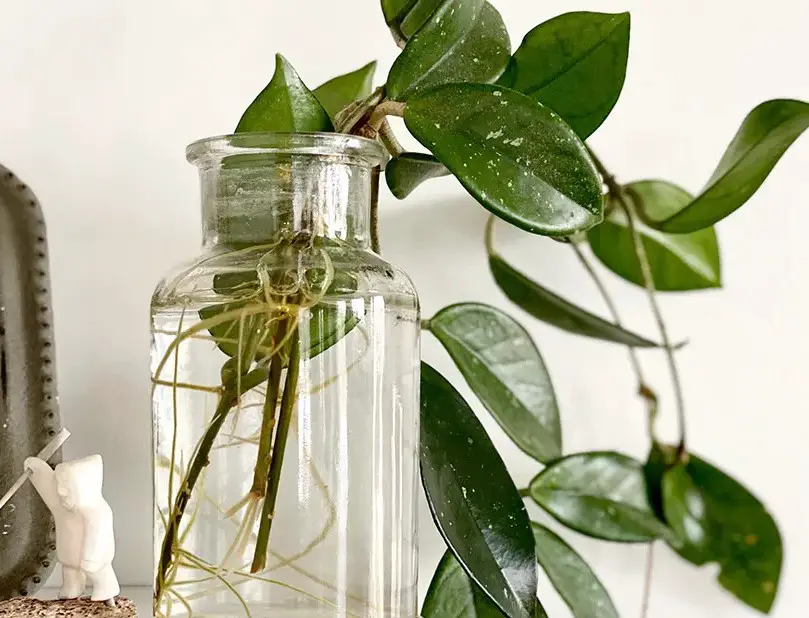
Hoya carnosa, known as the wax plant, showcases succulent, dark green, oval-shaped leaves with cream-colored variegated edges on trailing vines. It produces clusters of star-shaped, waxy, pink flowers. This easy-to-care-for indoor plant is popular for its thick, glossy leaves and interesting blooms.
While the vines thrive in water if kept clean, they are unlikely to flower in a vase. For those seeking blooms, growing Hoya carnosa in soil is recommended.
Hoya bella

Hoya bella, a charming member of the Hoya genus, features small, dainty, waxy leaves with white or silvery flecks on deep green foliage. Against a white wall, it displays clusters of fragrant, star-shaped white flowers with pink centers. This compact variety is ideal for smaller spaces, with structured leaves and adorable blooms adding a touch of beauty to any indoor setting.
Opt for a shorter vase and provide ample indirect light to allow the vines to flourish and showcase their full potential.
Chinese Evergreen
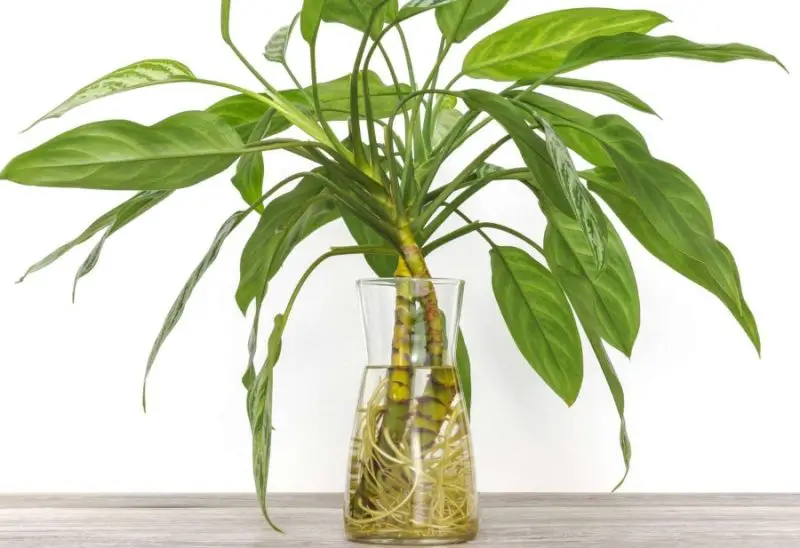
Aglaonema, commonly known as the Chinese Evergreen, is admired for its lush and striking lance-shaped leaves, which feature green hues accented with silver and gray variegations. When rooted in a decorative vase, this plant creates a captivating indoor display, perfect for foliage enthusiasts.
Its tolerance for lower light conditions makes it suitable for various indoor environments, while a vase with a narrow neck prevents the leaves from drooping into the water, maintaining its elegant appearance without the need for soil.
Mini Monstera
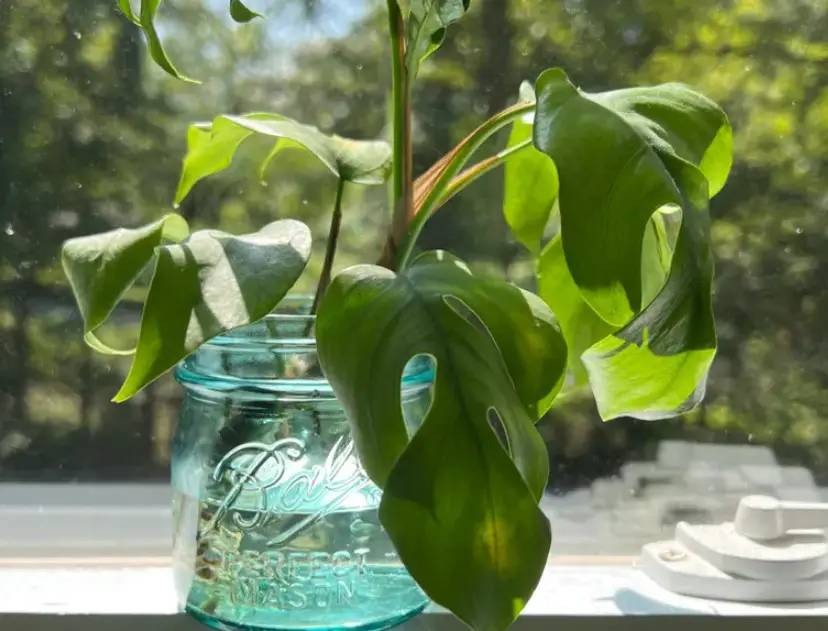
Rhaphidophora tetrasperma, often called the Mini Monstera, showcases small, fenestrated leaves with unique splits and holes, reminiscent of its larger counterpart. Its deep green, glossy foliage makes for a decorative display in a vase.
Despite its common name, it is not a true Monstera species. When rooting cuttings in a vase, opt for one with ample room to accommodate the thickening stems of this vine. The more cuttings you root, the fuller and more striking your display will become.
Nerve Plant
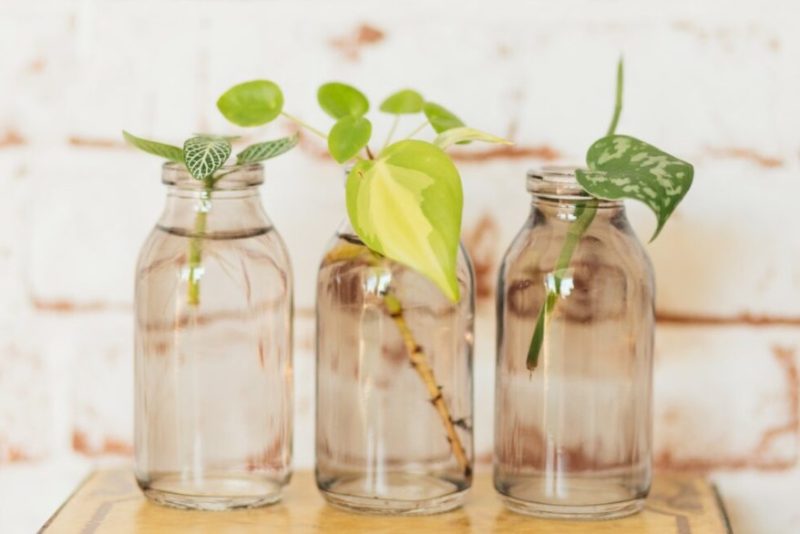
Nerve Plants, also known as Fittonia, are prized for their small, intricately veined leaves. With dark green foliage accented by bright pink and creamy white veins, they add a vibrant touch to any space.
While often paired with polka dot plants for their lush foliage, Nerve Plants are distinguished by their vein patterns resembling a nervous system. To prevent leaf drooping, opt for shorter vases that support the plant’s shorter stems and keep the leaves upright.
Baby’s Tears
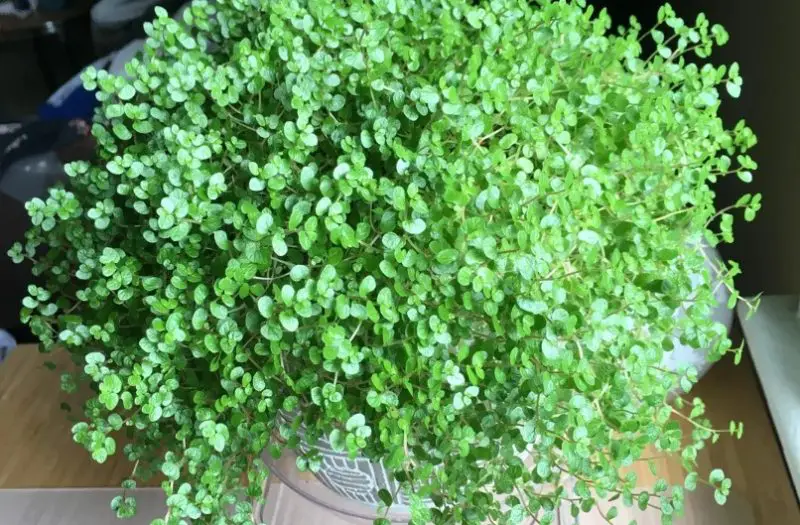
Soleirolia soleirolii, commonly known as Baby’s Tears, is adored for its tiny, delicate leaves resembling miniature teardrops. These bright green leaves densely cover creeping, trailing vines, adding a charming touch to any space.
Baby’s Tears, with their moss-like appearance, make an excellent houseplant choice. However, due to its thin and delicate vines, it can be challenging to root in water. To overcome this, consider using a medium like polystyrene with multiple holes to support the vines and keep them in place during rooting.
Syngonium

Syngonium, also known as the Arrowhead Plant, showcases arrowhead-shaped leaves with deep green and cream-pink variegation. As fast-growing houseplants, syngoniums can be confined to a vase, making them versatile options for indoor decor.
While the classic green arrowhead vine is a popular choice for vase display, colorful cultivars like ‘Neon’ offer a unique twist. Whichever variety you choose, syngoniums are sure to quickly fill out the vase and make a stunning centerpiece in any space.
English Ivy
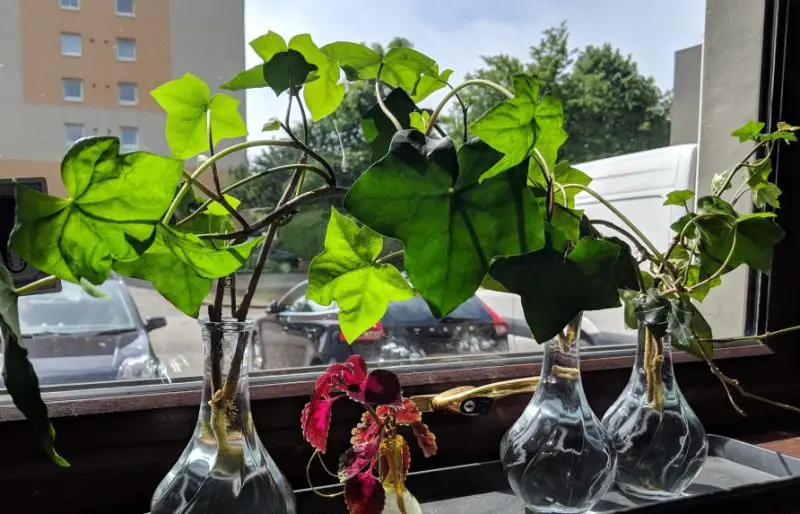
Hedera helix, commonly known as English Ivy, boasts distinctive, leathery leaves with a deep green hue. With its trailing and climbing growth habit, English Ivy adds a classic touch to any space. When rooted in water, its vines drape elegantly over the sides of the container, creating a picturesque display.
To maintain upright growth, place the container near a structure for the vines to climb along, or use wall clips to guide their growth in any desired pattern, adding versatility to its elegant appearance.
Swedish Ivy
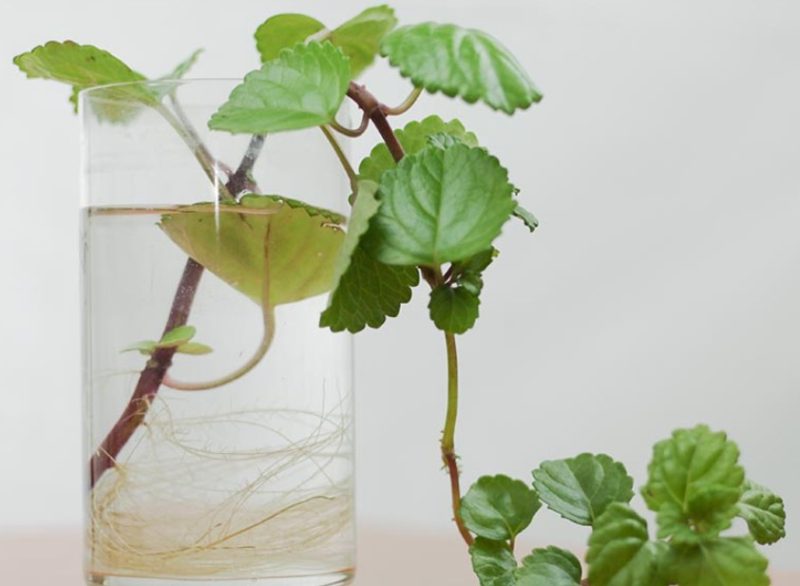
Swedish Ivy, scientifically known as Plectranthus australis, is a delightful houseplant adored for its cascading growth habit. Featuring bright green, rounded leaves with scalloped edges, it thrives indoors, particularly in low-light conditions. Despite its name, Swedish Ivy is unrelated to traditional English ivy.
This shade-loving plant requires little attention and grows rapidly indoors. Its vines can grow quite long, necessitating regular trimming to maintain tidiness. However, these cuttings can be easily propagated in water, thriving for several months without additional fertilization, as long as the leaves remain above the water line.
Inch Plant
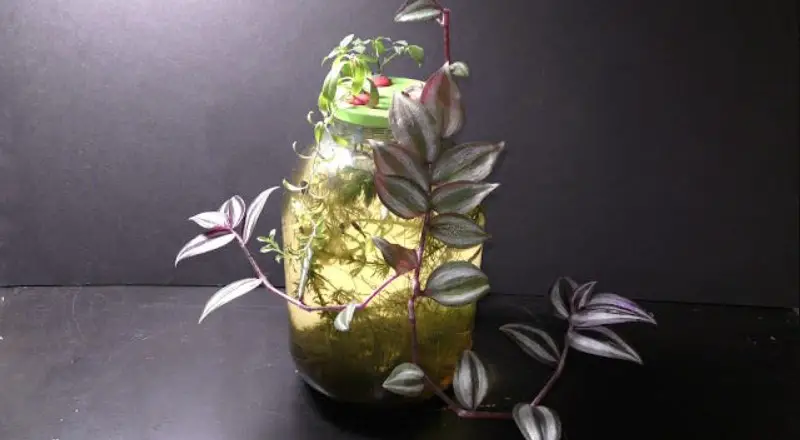
The Inch Plant, or Tradescantia zebrina, is a captivating houseplant celebrated for its vibrant foliage. With long lance-shaped leaves showcasing shades of green, silver, and purple, it adds a pop of color to any space. While Tradescantia is often deemed a troublesome weed outdoors, certain species, like Tradescantia zebrina, have become beloved among indoor gardeners.
Inch plant cuttings root easily in water and thrive with occasional nutrient supplements, making them a delightful addition to any collection.
Chinese Money Plant
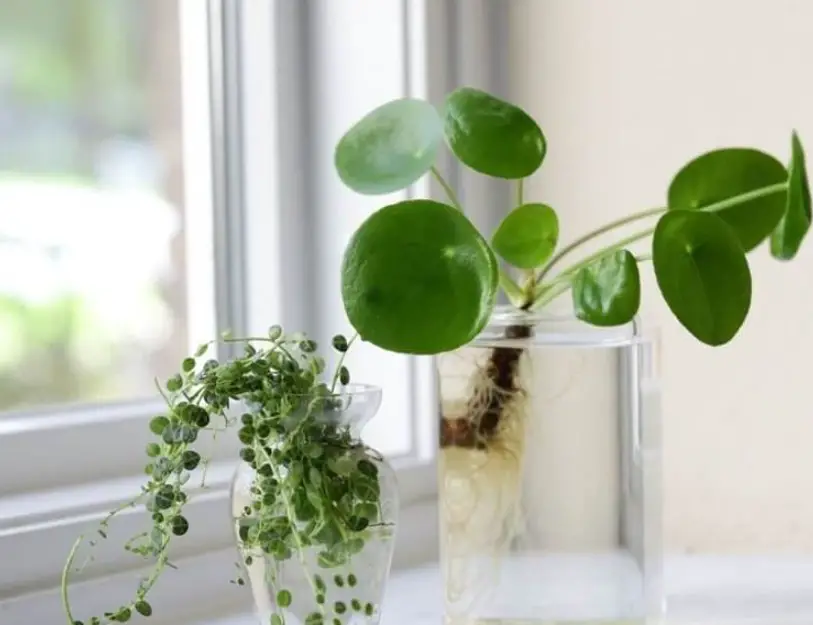
The Chinese Money Plant, or Pilea peperomioides, is adored for its charming appearance and unique growth pattern. Featuring round, pancake-shaped leaves atop slender stems, it’s no wonder this plant has become highly favored among enthusiasts.
With its cute leaves and distinct growth habit, the Chinese money plant is an excellent candidate for water propagation. Simply remove plantlets from the parent plant and place them in a small vase, transplanting to a larger one as they grow for long-term water cultivation.
Aluminum Plant
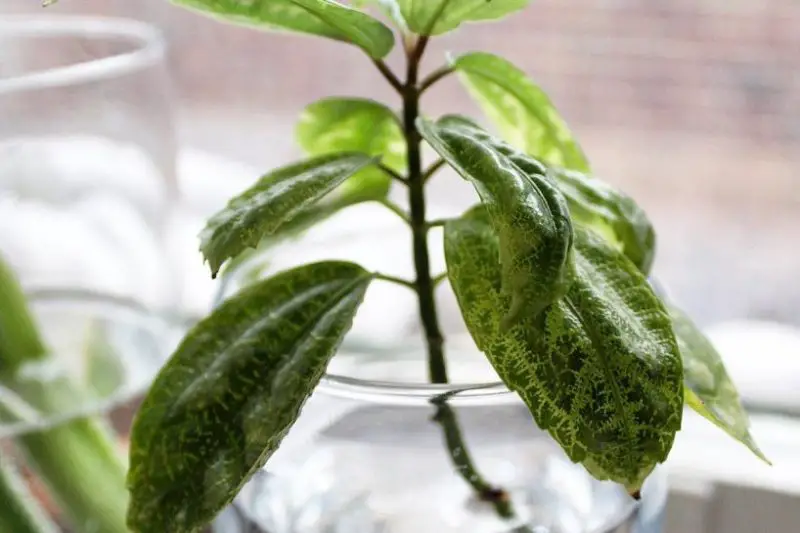
The Aluminum Plant, scientifically known as Pilea cadierei, is a stunning houseplant admired for its captivating foliage. Its elongated, pointed leaves boast a striking metallic silver pattern against a rich green background. Unlike its rounded counterpart, the Chinese money plant, the aluminum plant stands out with its pointed leaves and unique appearance.
With its relatively upright stems, it’s perfect for growing in a taller vase. Rooting several cuttings at once ensures a fuller display, showcasing the glossy silver and green leaves beautifully.
Basil

Basil is a must-have kitchen herb, making it worth growing indoors in water for regular harvests. With its broad, smooth, and vibrant green leaves growing in pairs along the stem, basil offers both aesthetic appeal and culinary versatility.
Opt for unique cultivars like ‘Purple Petra’ to enhance the ornamental value of your indoor garden. Ensure your basil plant receives ample sunlight and top up the water regularly to maintain optimal growth and flavor.
Green Onions
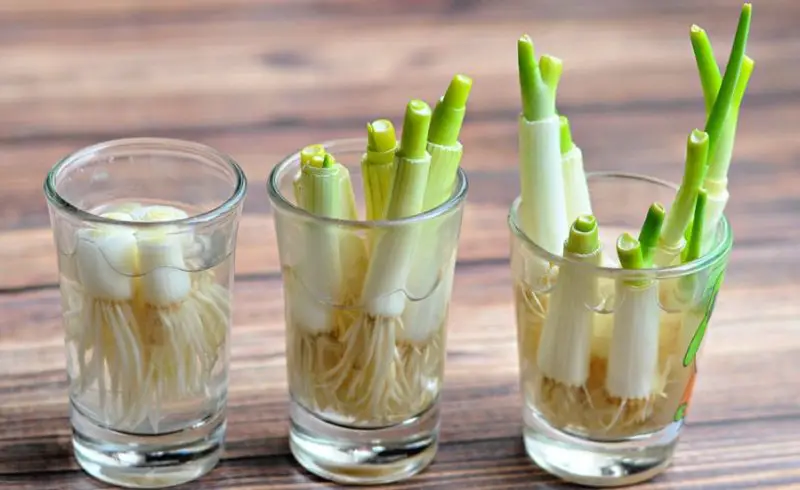
Green onions are perfect for regrowing indoors in water. Simply place the white stalk with roots attached in a glass of shallow water on a sunny windowsill and watch them rapidly regrow. To harvest, trim back the leaves as needed with clean scissors, allowing them to continue growing for an endless supply of fresh garnish.With their easy regrowth and versatile use, green onions are a must-have for any indoor garden.
Mint
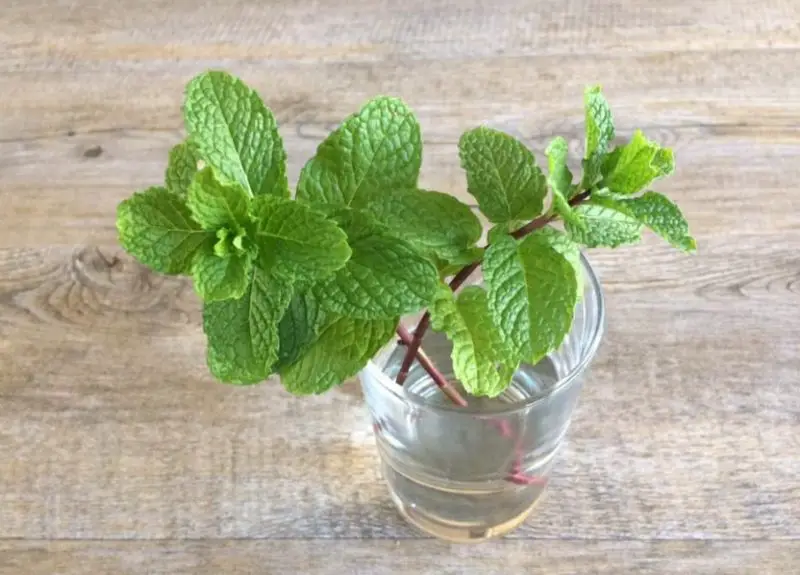
Mint is perfect for indoor water growth, offering versatility in culinary and aromatic uses. Its vibrant green leaves, slightly serrated and oval-shaped, grow in pairs on square stems. Whether harvested for dishes or left for ornamental value, mint thrives in a vase.
Indoors, it offers the aromatic essence without the outdoor spread. Enjoy its fresh flavor in dishes or dry for homemade tea, all from the convenience of your kitchen window.
Lucky Bamboo
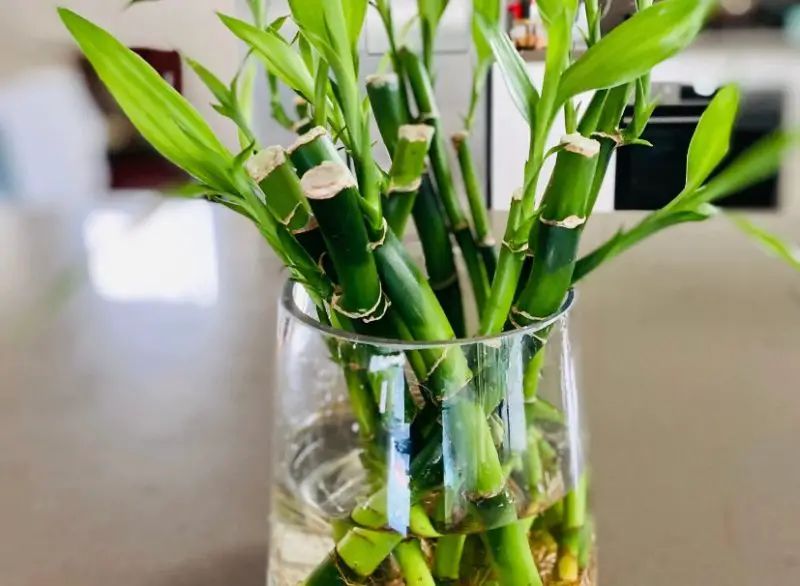
Lucky Bamboo, often mistaken for true bamboo, belongs to the Dracaena genus. Symbolizing good fortune, its slender stems and lance-shaped leaves offer a lush, tropical vibe. When placed in a suitable vase, it thrives with minimal care, requiring only clean water and abundant light.
Its versatile nature allows for training into various shapes, making it a dynamic centerpiece. To expand your collection, simply snip off the top and root it in water for continued growth.
Jade Plant
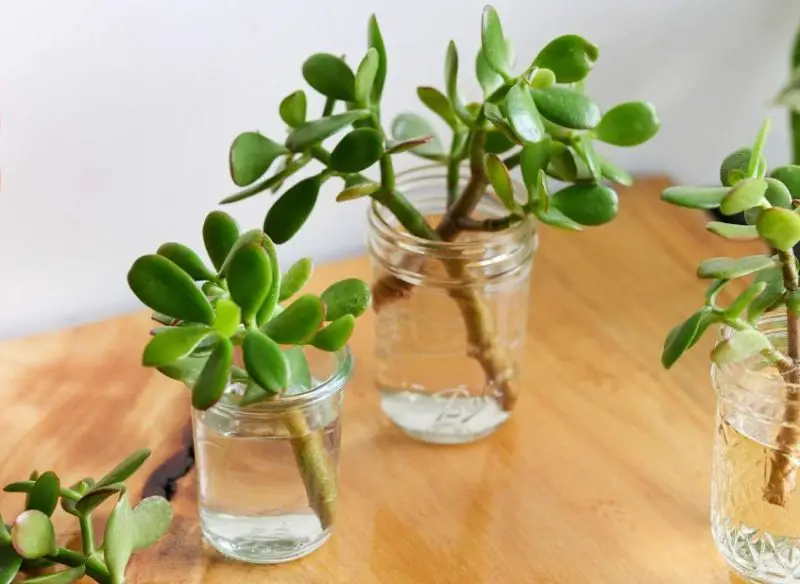
The jade plant, favored for its ability to thrive in lower light conditions, boasts plump oval leaves and woody stems. A popular choice for indoor growth, it’s often likened to bonsai trees for its shape. Also known as money plants in Feng Shui, they’re believed to bring success.
While they typically thrive in soil, jade plants can be trained to grow hydroponically with care. After allowing a cutting to become callous, place it in water, keeping the water line low. Regular sunlight and topping up the water will encourage long-term root growth in a glass.
Peace Lily
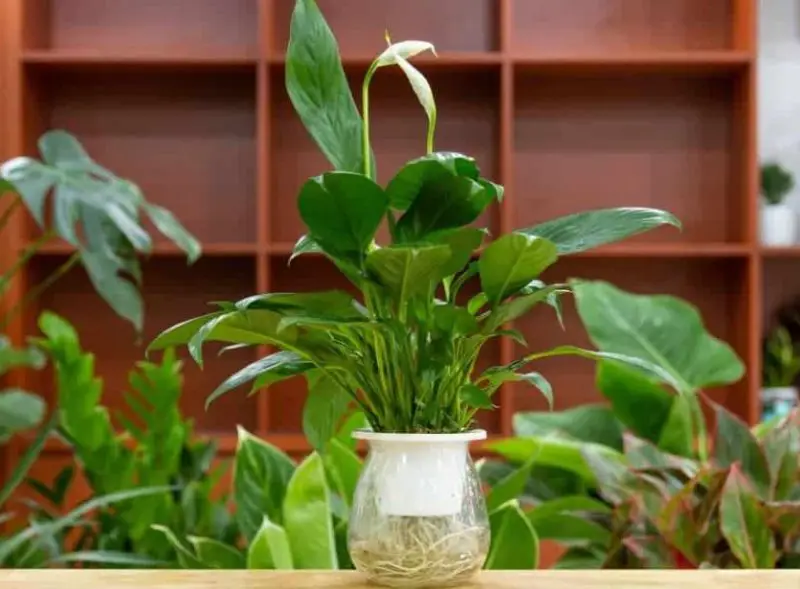
The peace lily is a classic and beginner-friendly houseplant, admired for its glossy, dark green leaves and elegant white flowers. While the leaves make it a great addition to any indoor space, it’s the stunning blooms that steal the show.
To grow it in water, divide an existing plant, selecting a section with fewer or shorter roots for an easier transition. With proper care, your peace lily will thrive in its water-filled vase, bringing beauty and tranquility to your home.
String of Hearts
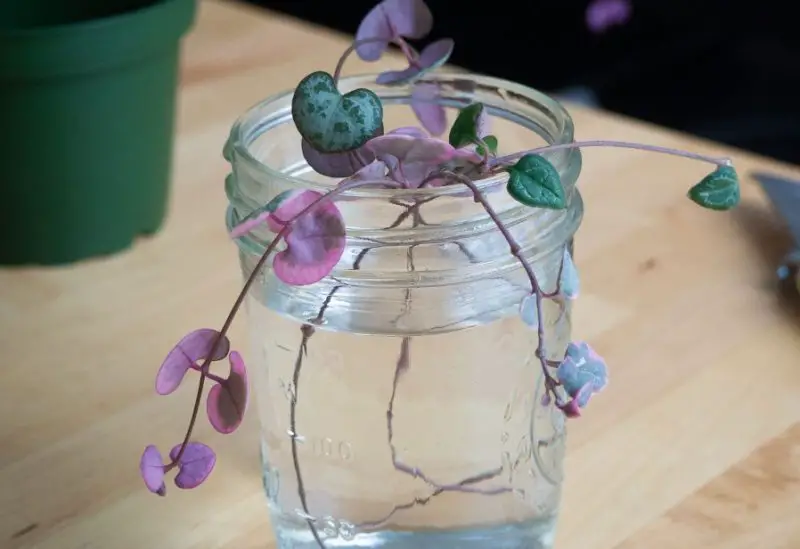
The String of Hearts, scientifically known as Ceropegia woodii, is a popular indoor succulent admired for its cascading vines and heart-shaped leaves. These leaves, variegated with shades of green and often adorned with silver stripes, grow along long, slender vines, creating a charming cascading effect.
When growing in water, it’s best to group several cuttings together in one vase to enhance the visual appeal. Additionally, ensure the container receives bright light for most of the day to prevent stem stretching.
Coleus
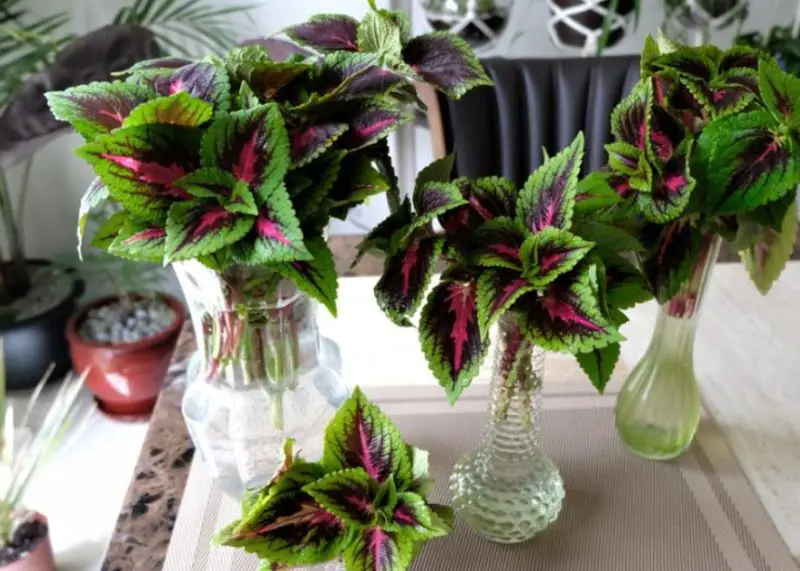
Coleus, typically an outdoor plant, thrives indoors in bright, indirect light, thanks to its shade-loving nature. Rooting coleus cuttings in water allows for worry-free indoor growth. The plant’s large, burgundy leaves with intricate green patterns create a mosaic-like effect, adding vibrant color to indoor spaces.
With numerous unique cultivars available, grouping coleus cuttings in a vase presents an opportunity to showcase their impressive variety and bring a touch of outdoor beauty inside.
Sweet Potato Vine
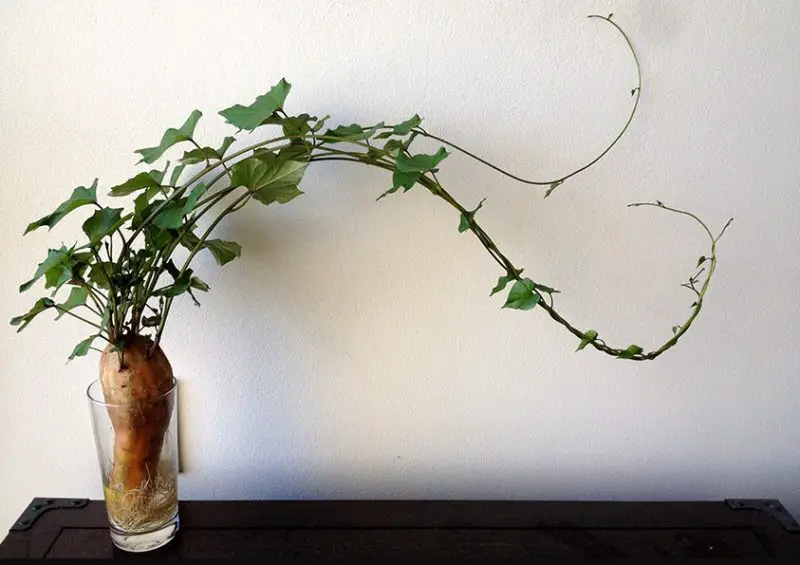
The sweet potato vine’s heart-shaped, glossy leaves make it a festive choice for home decor, especially during holidays like Thanksgiving. While typically grown outdoors as an annual, rooting sweet potato vines in water offers a convenient indoor alternative.
By placing them in a vase, you can control their environment and enjoy their vibrant foliage year-round. To enhance the display, consider grouping several vines together, perhaps choosing varieties with different leaf colors for added visual interest.
Hyacinth
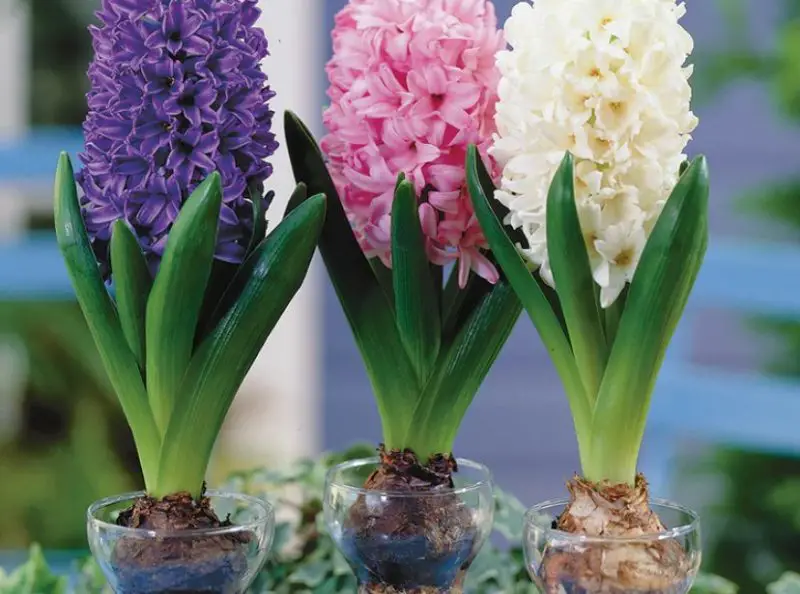
Hyacinths, with their captivating fragrance and stunning blooms, are a beloved choice for indoor cultivation. By chilling the bulbs for several weeks before rooting them in water, you can enjoy their delightful flowers slightly out of season and much closer to home. Specialized glasses allow the bulbs to sit above the water while their roots grow below.
With their long, narrow leaves and densely packed, fragrant white flowers, hyacinths add a touch of elegance to any indoor space.
Paperwhites
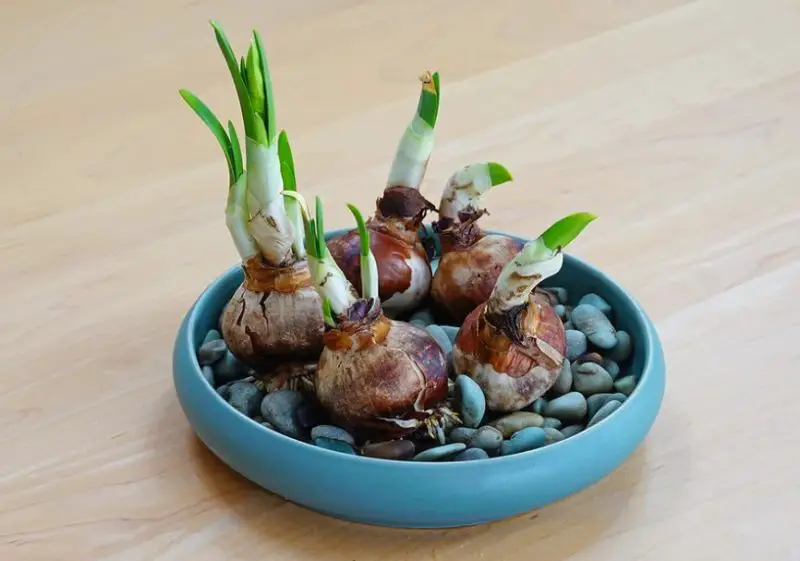
Paperwhite narcissus bulbs are a popular choice for indoor cultivation due to their preference for warm conditions. To grow them indoors, simply place the bulbs on a layer of pebbles in a container filled with water, ensuring the water line just touches the bottom of the bulbs. Continually top up with water as you wait for green growth to emerge.
With their slender, grass-like leaves and delicate star-shaped white flowers, paperwhites create a striking indoor display, especially when planted in groups.






